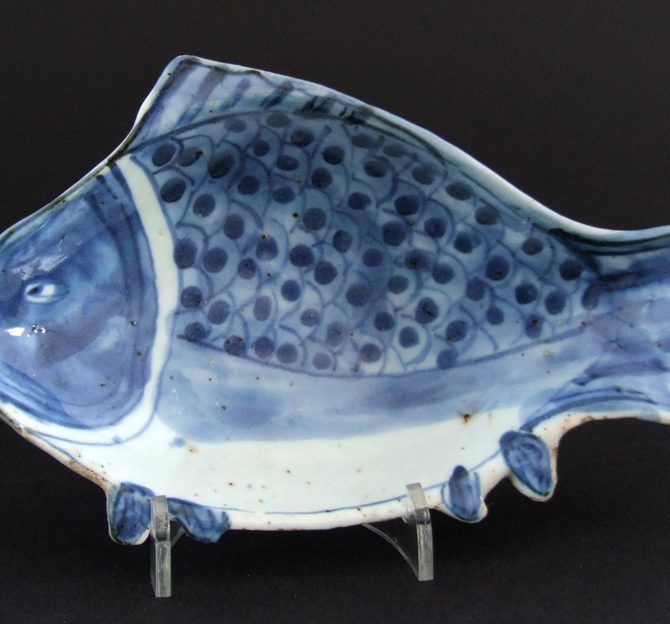
TIANQI 1621 – 1627. Transitional Porcelain.
An Unusual Transitional Blue and White Porcelain Ko-Sometsuke Dish, Late Ming Dynasty, Tianqi Period 1621-1627. Modelled in the Form of a Carp Li Yu. The Naturalistically Modelled Back is Unpainted and has Four Thickly Potted Circular Feet.
SOLD
- Condition
- Typical firing faults associated with Ming porcelain for the Japanese market. No damage.
- Size
- Length : 19 cm (7 1/2 inches)
- Provenance
- N/A
- Stock number
- 21574
- References
- For a set five of very similar Ming Ko-Sometsuke blue and white fish form dishes can be see in : Heibonsha Series Vol. 15 (Seito Kikutaro and Fuijio Koyama,1965) plate 62. For a further transitional carp dish of this type from the Butler Family Collection see : Trade and Transformation, Jingdezhen Porcelain for Japan, 1620-1645 (Julia B.Curtis, China Institute Gallery, New York 2006) page 54 plate 24. For a similar Transition Porcelain dish but modelled as a perch see : Recent Acquisitions 2010 (Marchant, 120 Kensington Church Street London W8 4BH) page 20 item 12. For another late Ming porcelain dish of this type see : Transitional Wares and Their Forerunners (The Oriental Ceramic Society of Hong Kong, 1981) page 162, plate 122.
Information
Ko-Sometsuke :
Ko-Sometsuke, meaning `Old Blue and White` is a term used to describe Chinese blue and white porcelain made for Japan. This late Ming porcelain was made from the Wanli period (1573-1620) and ended in the Chongzhen period (1628-1644), the main period of production being the 1620`2 and 1630`s. The porcelain objects produced were made especially for the Japanese market, both the shapes and the designs were tailored to Japanese taste, the production process too allowed for Japanese aesthetics to be included in the finished object. Its seams firing faults were added, repaired tears in the leather-hard body were too frequent to not, in some cases, be deliberate. These imperfections as well as the fritting Mushikui (insect-nibbled) rims and kiln grit on the footrims all added to the Japanese aesthetic. The shapes created were often expressly made for the Japanese tea ceremony meal, the Kaiseki, small dishes for serving food at the tea ceremony are the most commonly encountered form. Designs, presumably taken from Japanese drawings sent to China, are very varied, often using large amount of the white porcelain contrasting well with the asymmetry of the design.


